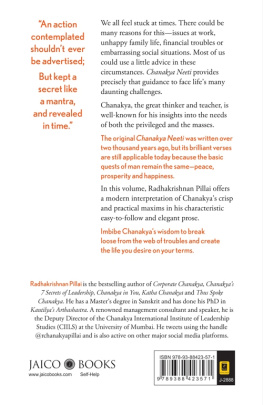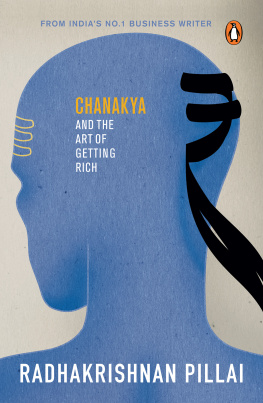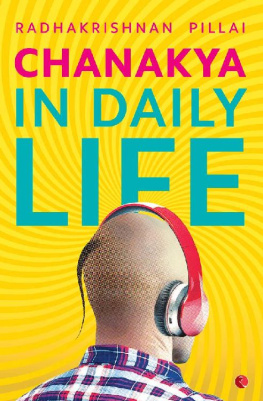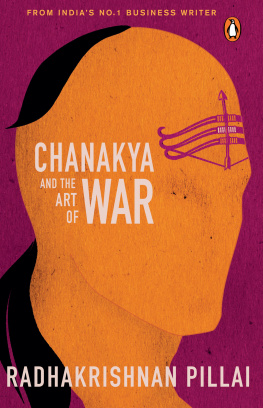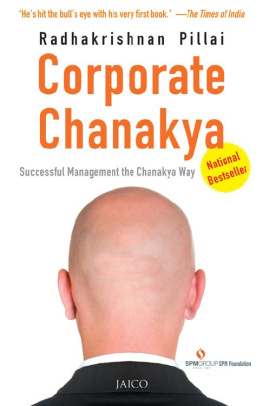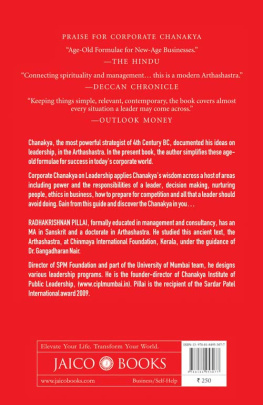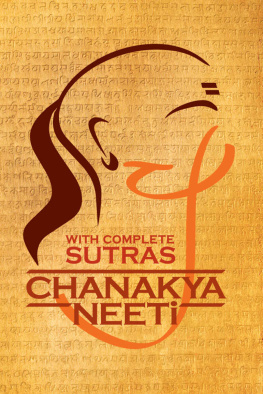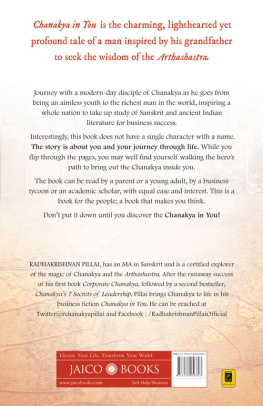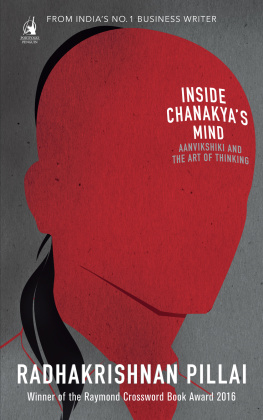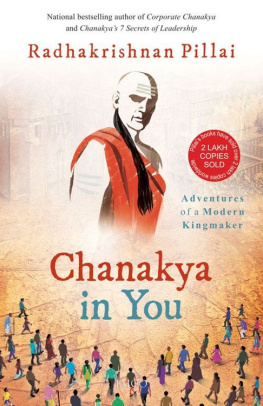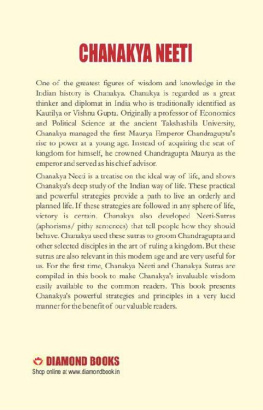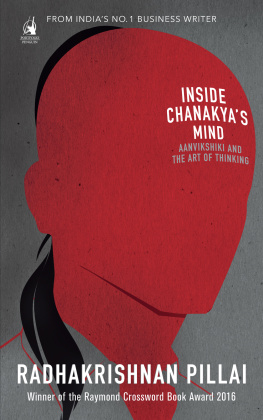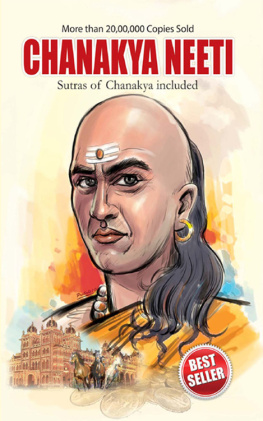Radhakrishnan Pillai - Chanakya Neeti
Here you can read online Radhakrishnan Pillai - Chanakya Neeti full text of the book (entire story) in english for free. Download pdf and epub, get meaning, cover and reviews about this ebook. year: 2019, genre: Religion. Description of the work, (preface) as well as reviews are available. Best literature library LitArk.com created for fans of good reading and offers a wide selection of genres:
Romance novel
Science fiction
Adventure
Detective
Science
History
Home and family
Prose
Art
Politics
Computer
Non-fiction
Religion
Business
Children
Humor
Choose a favorite category and find really read worthwhile books. Enjoy immersion in the world of imagination, feel the emotions of the characters or learn something new for yourself, make an fascinating discovery.
- Book:Chanakya Neeti
- Author:
- Genre:
- Year:2019
- Rating:5 / 5
- Favourites:Add to favourites
- Your mark:
- 100
- 1
- 2
- 3
- 4
- 5
Chanakya Neeti: summary, description and annotation
We offer to read an annotation, description, summary or preface (depends on what the author of the book "Chanakya Neeti" wrote himself). If you haven't found the necessary information about the book — write in the comments, we will try to find it.
Chanakya Neeti — read online for free the complete book (whole text) full work
Below is the text of the book, divided by pages. System saving the place of the last page read, allows you to conveniently read the book "Chanakya Neeti" online for free, without having to search again every time where you left off. Put a bookmark, and you can go to the page where you finished reading at any time.
Font size:
Interval:
Bookmark:
Published by Jaico Publishing House
A-2 Jash Chambers, 7-A Sir Phirozshah Mehta Road
Fort, Mumbai - 400 001
jaicopub@Jaicobooks.com
www.jaicobooks.com
Radhakrishnan Pillai
CHANAKYA NEETI
ISBN 978-93-88423-57-1
First Jaico Impression: 2020
All quoted verses are based on
Chanakyas Neeti Scripture by R. K. Sharma
published by Bharatiya Vidya Bhavan,
K. M. Munshi Marg, Mumbai-400007
Copyright R.K. Sharma
Used with the permission of Bharatiya Vidya Bhavan
No part of this book may be reproduced or utilized in
any form or by any means, electronic or
mechanical including photocopying, recording or by any
information storage and retrieval system,
without permission in writing from the publishers.
This book can tell you what to do and what not to do.
So let vivek shakti (the power of intellect) rise in each of you.
I dedicate this book to all great people who knew what to do and what
not to do in any given situation.
Those are the great men and women
who can each be truly called...
The Chanakya of their times.
INTRODUCTION
The moment we hear the two words Chanakya Neeti, were transported to another world, the world of Chanakya where there was order and discipline.
However, Chanakya Neeti can have various meanings for various people.
While Chanakya was a well-known figure in Indian history, not many people are familiar with the meaning of neeti.
In Sanskrit, neeti has many definitionsstrategies, policies, ideas, principles, methods, plans or tactics.
But before we start discussing this book Chanakya Neeti, lets first try and understand Chanakya.
This great thinker, philosopher, statesman and political strategist lived in the fourth century BC and led a life that is worth studying. He was known by three namesVishnugupta, Chanakya and Kautilya.
It is said that he was born with a full set of teeth, and that there was a prophecy which predicted that he will rule the country without occupying the seat of power. That is exactly what happened as his life unfolded.
His father was Chanak, who was a teacher of rajaneeti or political science. Chanak used to advise Dhanananda, the king of Magadha. However, Dhanananda was corrupt and people were unhappy with his leadership.
Chanak went on to create a public awakening, for which Dhanananda murdered him. Chanakya, then only a small boy, had to run away from Magadha to save his life. He reached Takshashila, and in Takshashila not only did he get a chance to survive but he continued his studies at the famous university. Chanakya was a brilliant student, and he soon became a teacher of political science, just like his father.
But destiny had other larger plans for him.
One day, he returned to Magadha, and Pataliputra, its capital, became his playground. He soon challenged Dhanananda and dethroned him.
He started training many young students in political science and leadership. He made one of his brightest students, Chandragutpa Maurya, the king of Magadha. Chanakya also defeated Alexander the Great, who was on his way to conquer the world.
Later, Chanakya brought together all the 16 regional kingdoms of India under one central government and thus established Akhanda BharatUnited India, and made Chandragupta its Emperor.
However, Chanakya was a teacher at his core. He wanted to pass on his wisdom and experiences to the next generation. He, therefore, wrote his magnum opus, Kautilyas Arthashastraone of the greatest books ever written on leadership and good governance.
The Arthashastra has 6000 sutras or formulas based on which he guided Chandragupta on how to govern well. This book is still studied by scholars across the globe and our generation still derives guidance and inspiration from it.
Chanakya wrote the Arthashastra for kings and leaders. But what about the common man? Why would a teacher neglect the masses? He didnt. He wanted to guide the common man too.
Therefore, it is said that while the Arthashastra with its 6000 sutras was meant for kings, he wrote another book, Chanakya Neeti, for the common man. What is in your hands is this Chanakya Neeti.
There are many arguments about the origins of Chanakya Neetiwho wrote it, where, when, etc. Some scholars have said that it is the essence of the original Arthashastra modified for the common man while some others have debated that it was compiled by some students of Chanakya to distill the wisdom of the Arthashastra for the masses.
Whatever be the debate around Chanakya Neeti, it surely gives us in a concise manner what Chanakya wanted us to know. If you cannot study the full Arthashastra, I suggest that you at least start with Chanakya Neeti.
I am sure after reading this book you will be inspired to go through the 6000 sutras of the Arthashastra. I promise you that if you earnestly study these two books, your life will never be the same again; it will change for the better.
Now, about the book in your hands: the original Chanakya Neeti has many sources and there are various versions available across India. I am not a historian and it is difficult to find the original book as such. But after studying about 40 different versions, I have come to the conclusion that they are all more or less the same.
For easy reference, I have used the book Chanakyas Neeti Scripture, which is among the first verse-by-verse English translations available of the original Sanskrit text. This was done by the great scholar R.K. Sharma and it was published by Bharatiya Vidya Bhavan. My salutations to Mr. Sharma for his phenomenal work in translating each of Chanakyas ideas into simple English so that people around the world can read and enjoy them.
Writing this book has been one of my most difficult projects till date. I have written over 15 books on Chanakya in addition to research papers and other articles for magazines and newspapers. But writing commentary on each verse in this book was a challenge in itself.
How can a common man like me write a commentary on a great ancient scripture like Chanakya Neeti? Commentary or bhashya (in Sanskrit) is the privilege of great scholars. In the past you could write one on a shastra (scripture) like Chanakya Neeti only if you are an authority on the subject, and that too with other scholars approvals.
So when I started writing my commentary on Chanakya Neeti, I remembered my lifelong guides to understand Chanakyas wisdom: Swami Tejomayananda and Swami Advayananda of the Chinmaya Mission; Dr. Gangadharan Nair and Dr. Shubhada Joshimy teachers from the Chinmaya University and University of Mumbai respectively. They have been my constant source of inspiration.
The commentary you are about to read is based directly on Chanakyas original Sanskrit text, which was primarily written for male readers. He lived during a time where casteism and discrimination against women were considered normal. As a result, many of his original thoughts may seem outdated or outrageous in todays context. Chanakyas writing reflects the social practices prevalent in his lifetime. The idea behind this book is not to cause offence to any religion, caste, race, gender or place. I have tried my best to provide a modern take on all the verses you will come across in these pages, so that you get to understand them in a broader context. Its my sincere plea, dear reader, to keep these words in mind as you go through this book.
I would like to thank my publishers, Jaico Publishing House, for bringing out yet another milestone of a book on Chanakya through me. Akash Shah is more a friend than a publisher to me. I have yet to meet another great human being like him. Simple and profound, he has always been a constant support to me as an author ever since our first book,
Next pageFont size:
Interval:
Bookmark:
Similar books «Chanakya Neeti»
Look at similar books to Chanakya Neeti. We have selected literature similar in name and meaning in the hope of providing readers with more options to find new, interesting, not yet read works.
Discussion, reviews of the book Chanakya Neeti and just readers' own opinions. Leave your comments, write what you think about the work, its meaning or the main characters. Specify what exactly you liked and what you didn't like, and why you think so.

